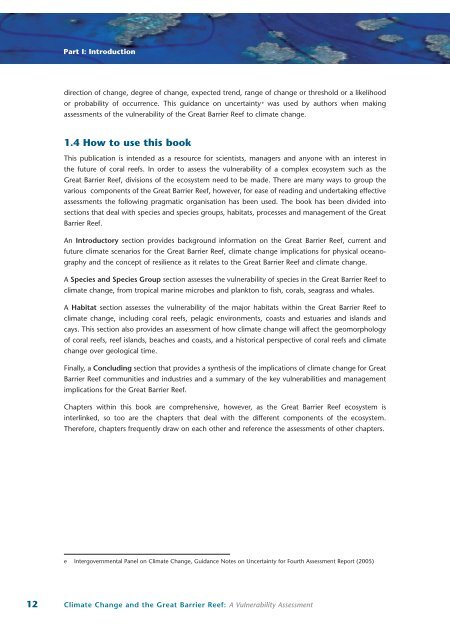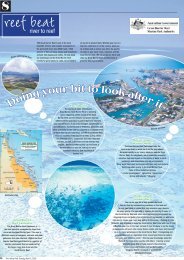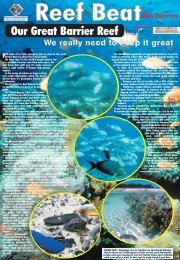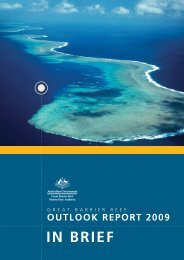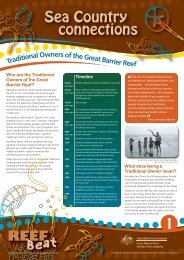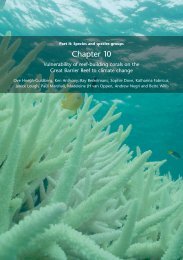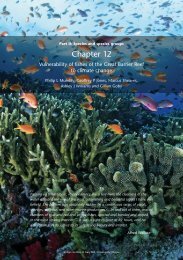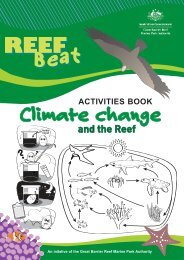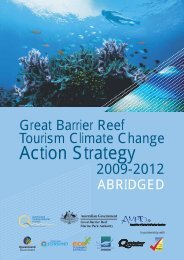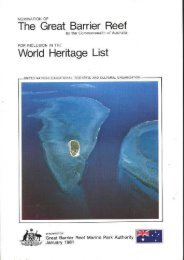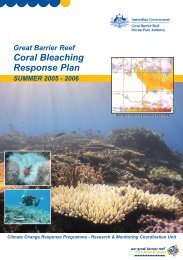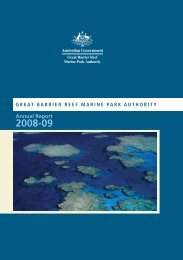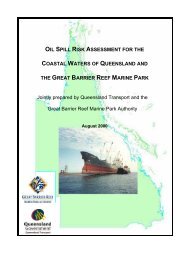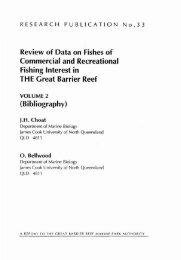Chapter 1: Introduction to the Great Barrier Reef and climate change
Chapter 1: Introduction to the Great Barrier Reef and climate change
Chapter 1: Introduction to the Great Barrier Reef and climate change
Create successful ePaper yourself
Turn your PDF publications into a flip-book with our unique Google optimized e-Paper software.
Part I: <strong>Introduction</strong><br />
direction of <strong>change</strong>, degree of <strong>change</strong>, expected trend, range of <strong>change</strong> or threshold or a likelihood<br />
or probability of occurrence. This guidance on uncertainty was used by authors when making<br />
assessments of <strong>the</strong> vulnerability of <strong>the</strong> <strong>Great</strong> <strong>Barrier</strong> <strong>Reef</strong> <strong>to</strong> <strong>climate</strong> <strong>change</strong>.<br />
1.4 How <strong>to</strong> use this book<br />
This publication is intended as a resource for scientists, managers <strong>and</strong> anyone with an interest in<br />
<strong>the</strong> future of coral reefs. In order <strong>to</strong> assess <strong>the</strong> vulnerability of a complex ecosystem such as <strong>the</strong><br />
<strong>Great</strong> <strong>Barrier</strong> <strong>Reef</strong>, divisions of <strong>the</strong> ecosystem need <strong>to</strong> be made. There are many ways <strong>to</strong> group <strong>the</strong><br />
various components of <strong>the</strong> <strong>Great</strong> <strong>Barrier</strong> <strong>Reef</strong>, however, for ease of reading <strong>and</strong> undertaking effective<br />
assessments <strong>the</strong> following pragmatic organisation has been used. The book has been divided in<strong>to</strong><br />
sections that deal with species <strong>and</strong> species groups, habitats, processes <strong>and</strong> management of <strong>the</strong> <strong>Great</strong><br />
<strong>Barrier</strong> <strong>Reef</strong>.<br />
An Introduc<strong>to</strong>ry section provides background information on <strong>the</strong> <strong>Great</strong> <strong>Barrier</strong> <strong>Reef</strong>, current <strong>and</strong><br />
future <strong>climate</strong> scenarios for <strong>the</strong> <strong>Great</strong> <strong>Barrier</strong> <strong>Reef</strong>, <strong>climate</strong> <strong>change</strong> implications for physical oceanography<br />
<strong>and</strong> <strong>the</strong> concept of resilience as it relates <strong>to</strong> <strong>the</strong> <strong>Great</strong> <strong>Barrier</strong> <strong>Reef</strong> <strong>and</strong> <strong>climate</strong> <strong>change</strong>.<br />
A Species <strong>and</strong> Species Group section assesses <strong>the</strong> vulnerability of species in <strong>the</strong> <strong>Great</strong> <strong>Barrier</strong> <strong>Reef</strong> <strong>to</strong><br />
<strong>climate</strong> <strong>change</strong>, from tropical marine microbes <strong>and</strong> plank<strong>to</strong>n <strong>to</strong> fish, corals, seagrass <strong>and</strong> whales.<br />
A Habitat section assesses <strong>the</strong> vulnerability of <strong>the</strong> major habitats within <strong>the</strong> <strong>Great</strong> <strong>Barrier</strong> <strong>Reef</strong> <strong>to</strong><br />
<strong>climate</strong> <strong>change</strong>, including coral reefs, pelagic environments, coasts <strong>and</strong> estuaries <strong>and</strong> isl<strong>and</strong>s <strong>and</strong><br />
cays. This section also provides an assessment of how <strong>climate</strong> <strong>change</strong> will affect <strong>the</strong> geomorphology<br />
of coral reefs, reef isl<strong>and</strong>s, beaches <strong>and</strong> coasts, <strong>and</strong> a his<strong>to</strong>rical perspective of coral reefs <strong>and</strong> <strong>climate</strong><br />
<strong>change</strong> over geological time.<br />
Finally, a Concluding section that provides a syn<strong>the</strong>sis of <strong>the</strong> implications of <strong>climate</strong> <strong>change</strong> for <strong>Great</strong><br />
<strong>Barrier</strong> <strong>Reef</strong> communities <strong>and</strong> industries <strong>and</strong> a summary of <strong>the</strong> key vulnerabilities <strong>and</strong> management<br />
implications for <strong>the</strong> <strong>Great</strong> <strong>Barrier</strong> <strong>Reef</strong>.<br />
<strong>Chapter</strong>s within this book are comprehensive, however, as <strong>the</strong> <strong>Great</strong> <strong>Barrier</strong> <strong>Reef</strong> ecosystem is<br />
interlinked, so <strong>to</strong>o are <strong>the</strong> chapters that deal with <strong>the</strong> different components of <strong>the</strong> ecosystem.<br />
Therefore, chapters frequently draw on each o<strong>the</strong>r <strong>and</strong> reference <strong>the</strong> assessments of o<strong>the</strong>r chapters.<br />
Intergovernmental Panel on Climate Change, Guidance Notes on Uncertainty for Fourth Assessment Report (2005)<br />
12 Climate Change <strong>and</strong> <strong>the</strong> <strong>Great</strong> <strong>Barrier</strong> <strong>Reef</strong>: A Vulnerability Assessment


